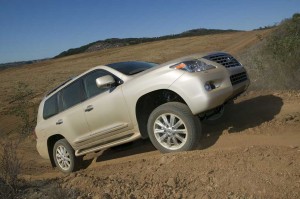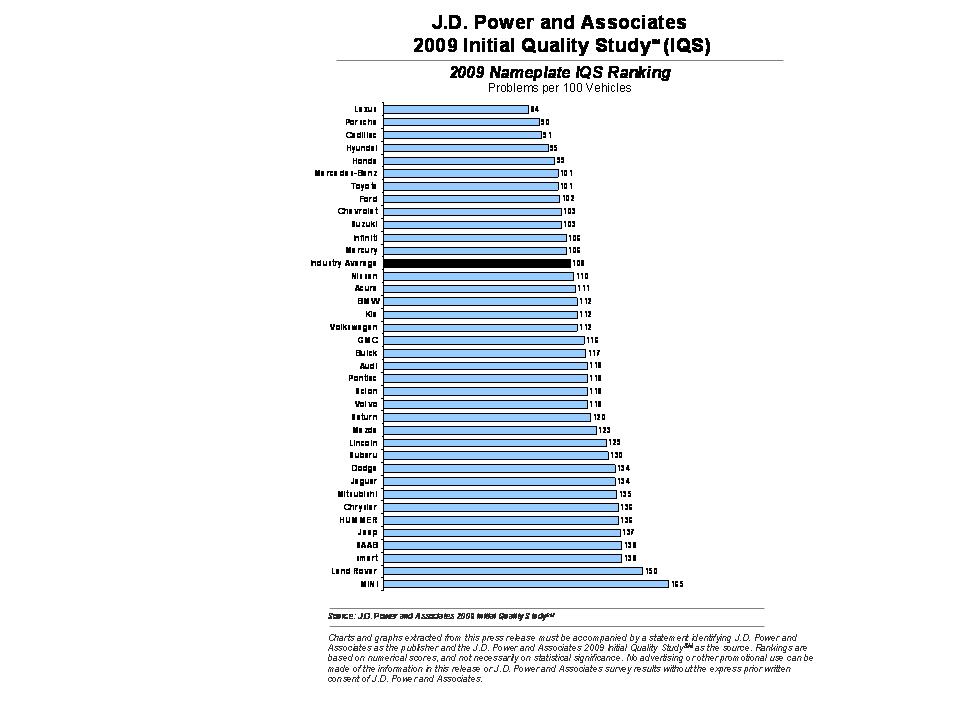
Detroit's Big Three makers made huge strides in quality, according to the latest J.D. Power Initial Quality Survey, but the single highest-quality product was the Lexus LX sport-utility vehicle.
Despite distracting financial problems, Detroit’s Big Three automakers showed a substantial improvement in off-the-assembly-line quality, according to the latest Initial Quality Survey by automotive gurus J.D. Power and Associates.
Chrysler, Ford and General Motors’ various brands scored a collective 10% improvement on the closely-watched 2009 IQS, though the industry, as a whole, experienced significant improvements. That means that while the so-called quality gap is closing, imports once again retain the lead.
Among the 37 brands included in the yearly quality report, long-dominant Lexus again took the number one spot with an average of just 84 problems reported per 100 vehicles, (or 84 PP100). Porsche, which had led the list for the last two years, slipped into the number two spot, while Cadillac jumped from 10th to 3rd. Significantly, the Korean maker, Hyundai, surged to the 4th position, a major gain for a manufacturer long relegated to the bottom end of the quality charts.
The industry average, for 2009, came to 108 problems – down from 118, last year – which works out to just slightly more than one per vehicle, though Mini, the lowest-ranked maker, suffered from 165 PP100.
“It’s fair to say that new vehicle quality is better than it’s ever been,” said David Sargent, JDPA’s vice president of automotive research, “in terms of the absence of problems.”
 Notably, four Detroit brands – Cadillac, Ford, Chevrolet and Mercury – ranked above the industry average. And Power officials reported that on the whole, the Big Three “outpaced (the) industry-wide improvement” in quality.
Notably, four Detroit brands – Cadillac, Ford, Chevrolet and Mercury – ranked above the industry average. And Power officials reported that on the whole, the Big Three “outpaced (the) industry-wide improvement” in quality.
“Even in the face of unprecedented challenges, the Detroit automakers are keeping their focus on designing and building high-quality vehicles, which is a precondition for long-term success,” noted Sargent.
Industry research has long revealed a growing number of car buyers who ignore domestic brands, and recent surveys have indicated that situation has worsened, in recent months, for GM and Chrysler, the two American manufacturers who remain in business only after winning multi-billion-dollar federal bailouts.
So, said, Sargent, this new demonstration of quality gains by GM and Chrysler could be critical to their long-term success. “High quality generally translates into reduced re-engineering costs and lower warranty expenses during a vehicle’s life cycle. High quality also enhances an automaker’s reputation for reliability, which is a critical purchase consideration for many consumers.”
Broken down between cars, trucks and crossovers, Power data show that Detroit’s Big Three had fewer problems with their trucks and about the same number of problems with passenger cars as did the imports. But they lagged notably behind in the crossover category.
And even with their gains, Detroit’s three makers were only able to capture leadership in 7 of the 22 individual product segments covered by the IQS – which surveyed 80,900 owners and lessees, after the first 90 days of operating a 2009 model. Ford Motor Co. received four awards, including ties by both the Ford Edge and Ford F-150 pickup, as well as the Ford Mustang, and the Mercury Sable. GM garnered segment awards with the Chevrolet Trailblazer and GMC Yukon. And Chrysler won with the PT Cruiser.
But Toyota Motor Corp., which had suffered from a few quality snags, in recent years, was back in form, garnering awards in 10 segments, more than any other maker. Half of those went to its luxury brand, Lexus, where the LX sport-ute experienced a best-in-the-industry problem count of just 52 per 100 vehicles.
Nissan and Honda both won two segment awards, while Hyundai grabbed one with its Elantra sedan.
Significantly, while Porsche came in second overall, among manufacturers, it did not lead any individual product segment. Not a single European maker topped one of the 22 product categories. In fact, only two of the makers, Porsche and Mercedes-Benz, scored above the 108 PP100 industry average in the overall brand category.
One of the more significant findings of the 2009 IQS is that manufacturers are starting to launch new products at high quality levels. Historically, even the best automakers tended to have problems – often serious ones – during the start-up of production, working the bugs out in subsequent years.
“Achieving high levels of initial quality in all-new models is one of the greatest challenges for manufacturers,” said Power analyst Sargent.
But Power data revealed a number of all-new products, including the Hyundai Genesis, Kia Borrego, Toyota Venza and Volkswagen CC, performing better than their segment averages. The same was the case with some significantly updated products, like the Acura TL, Ford F-150, Honda Pilot and Nissan 350Z.
While the IQS spotlight focuses on product quality, Power also analyzes the performance of individual assembly plants. The annual Platinum Plant Quality Award went to the Toyota line in Higashi-Fuji, Japan; producing the Lexus SC430 and Toyota Corolla, it averaged just 29 problems per 100 vehicles. The Honda plant, in East Liberty, Ohio, producing such models as the Civic sedan and CR-V, captured the Gold Award. Daimler’s plant, in East London, South Africa, was given another Gold Award for its work on the Mercedes C-Class.
|
IQS 2009 TOP THREE MODELS |
|
Sub-Compact Car |
|
Highest Ranked: Toyota Yaris |
|
Hyundai Accent |
|
Honda Fit |
|
|
|
Compact Car |
|
Highest Ranked: Hyundai Elantra Sedan |
|
Toyota Prius |
|
Honda Civic |
|
|
|
Compact Sporty Car* |
|
Highest Ranked: Scion tC |
|
Volkswagen GTI |
|
|
|
Compact Premium Sporty Car* |
|
Highest Ranked: Nissan Z |
|
Mercedes-Benz SLK-Class |
|
|
|
Entry Premium Vehicle |
|
Highest Ranked: Lexus IS |
|
Cadillac CTS (tie) |
|
Infiniti G-Series (tie) |
|
|
|
Midsize Premium Car |
|
Highest Ranked: Lexus GS |
|
Acura RL |
|
Lexus ES |
|
|
|
Midsize Sporty Car* |
|
Highest Ranked: Ford Mustang |
|
|
|
Large Premium Car* |
|
Highest Ranked: Lexus LS |
|
Mercedes-Benz S-Class |
|
|
|
Midsize Car |
|
Highest Ranked: Nissan Altima |
|
Pontiac G6 |
|
Chevrolet Malibu |
|
|
|
Large Car |
|
Highest Ranked: Mercury Sable |
|
Toyota Avalon |
|
Chevrolet Impala |
|
|
|
Truck/Multi-Activity Vehicle (MAV) Segments |
|
|
|
Compact MAV |
|
Highest Ranked: Chrysler PT Cruiser Wagon (tie); Honda CR-V (tie) |
|
Mitsubishi Outlander |
|
|
|
Midsize MAV |
|
Highest Ranked: Chevrolet TrailBlazer (tie); Ford Edge (tie); Toyota 4Runner (tie) |
|
|
|
Large MAV* |
|
Highest Ranked: GMC Yukon |
|
Chevrolet Tahoe |
|
|
|
Midsize Premium MAV |
|
Highest Ranked: Lexus GX |
|
Lexus RX |
|
Cadillac SRX |
|
|
|
Large Premium MAV |
|
Highest Ranked: Lexus LX |
|
Cadillac Escalade |
|
Mercedes-Benz GL-Class |
|
|
|
Large Pickup |
|
Highest Ranked: Ford F-150 (tie); Toyota Tundra (tie) |
|
Chevrolet Avalanche |
|
|
|
Midsize Pickup |
|
Highest Ranked: Honda Ridgeline |
|
Nissan Frontier |
|
Ford Ranger |
|
|
|
Minivan* |
|
Highest Ranked: Toyota Sienna |
|
Honda Odyssey |
|
NOTE: For a segment award to be issued, there must be at least three models with sufficient sample that comprise 80 percent of market sales within an award segment. There were only two premium sporty models and no large van models with sufficient sample size, thus no premium sporty or large van awards have been issued. *No other model in this segment performs above the segment average. |


Not surprising when I see the vehicles at the top of the lists…all have been in production for a lengthy amount of time. That Lexus truck platform is as old as the hills, no? Same with the Blazer and the PT cruiser.
What, no Grand Marquis?
Interesting to see GMC, Cadillac, Chevrolet Impala, Malibu and Trailblazer and the Pontiac G6 showing up but nothing from Buick. Also, seeing Ford Sable and the Impala bracketing the Toyota Avalon is encouraging for those who want to see Detroit’s automakers compete but the domestics are conspicuous in their absence from the sub-compact, compact and sporty compact ranks. Where should they be putting their scant product development resources? What does the public want?
I’ve long thought the quality gap should perpetually narrow, even as automakers launch new vehicles. These ratings are good not only for buyers but also industry types to examine how well each company hands off the assembly & engineering knowledge from one model to the next.
Two points specifically: I’m interested to watch Saab’s scores in the coming years under new ownership. Second, the Ranger ought to be a category winner by now, largely unchanged since when? Last millennium?